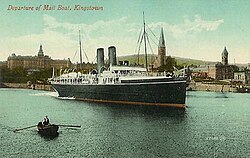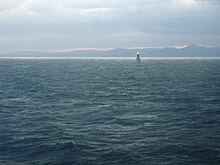RMS Leinster
|
||||||||||||||||||||
|
||||||||||||||||||||
|
||||||||||||||||||||
|
||||||||||||||||||||
The RMS Leinster was a passenger ship of the shipping company City of Dublin Steam Packet Company of Dublin . The steamer, which was commissioned in 1897, transported passengers, mail and freight on regular services between Dún Laoghaire (then Kingstown) on the Irish east coast and Holyhead on the British island of Anglesey across the Irish Sea . On October 10, 1918, the Leinster was sunk by the German submarine UB 123 by two torpedoes in front of the Kish Bank sandbank in Dublin Bay . Of the 771 passengers and crew members, 501 died. Thus, one of the greatest losses of human life was to be deplored by the sinking of a civilian ship in World War I after the Lusitania . It is also the worst shipping accident in the Irish Sea to date .
The ship
The Leinster was commissioned in 1895 along with three other ships from Laird Brothers in the English city of Birkenhead . Her sister ships were the Ulster (launched June 27, 1896), the Munster (launched December 21, 1896) and the Connaught (launched September 21, 1897). The ships are named after the four historic provinces of Ireland . The City of Dublin Steam Packet Company was a Dublin-based shipping company founded in 1822 that specialized in ferry and mail services from Dublin to British ports such as Liverpool , Belfast and Glasgow . In 1850, the British Admiralty for the first time awarded contracts for mail transport to private companies. Their ships were allowed to use the prefix RMS for “ Royal Mail Steamer ” (German: Royal Mail Steamer ). The shipping company took part.
The 115.2 meter long steel Leinster was propelled with twin screws and could reach a top speed of 24 knots. It was launched on September 12, 1896 and was completed in January 1897. During her test drives on February 27, 1897, the Leinster undercut the record for the fastest crossing from Kingstown to Holyhead by six minutes. She was in the service for a total of 20 years. On September 8, 1902, the steamer rammed and sank the Kish Bank lightship Albatross in Dublin Bay . There were no dead. The Leinster picked up the crew and brought them to Holyhead .
After her sister ship Connaught was sunk on March 3, 1917 by the German submarine U 48 , the Leinster and her other sister ships were given a camouflage paint job. It was also equipped with a 6-pounder gun and two cannons. However, the ship was not used as a troop transport or for a similar war-relevant purpose, but remained in regular passenger traffic.
The last ride
Departure in Ireland
On Thursday, October 10, 1918 at 8:50 a.m., the Leinster departed from Carlisle Pier in Kingstown for a crossing to Holyhead. There she was scheduled to moor at Salt Island's Admiralty Pier. The command was the 61-year-old captain William Birch, a native Irish, who had settled with his family on Anglesey. The ship went without an escort . The weather was clear, but there was a strong wind from the south-southeast.
On board were 77 crew members, three were gunners of the Royal Navy and 691 passengers. Passengers included 489 members of the Navy, Army, Air Force and medical personnel from the United Kingdom, Ireland, Canada , Australia , New Zealand and the United States , including soldiers, officers, engineers, doctors and nurses. There were also 22 postal workers from the Dublin Post Office on board who ran the ship's mail room. The remaining 180 passengers were civilians, many of them women and children. A total of 771 people were on board. At 09:42 the Leinster reached the Kish Bank lightship.
Sinking
At 9:50 a.m., when the Leinster had only traveled 16 miles and was passing the sandbank Kish Bank in Dublin Bay to the east, passengers on the deck of the ship saw a torpedo approaching the port side of the steamer. He missed the Leinster and shot past her bow. It was a torpedo from UB 123 , a German submarine of type UB III , that was only for half a year in the service and under the command of 27-year-old lieutenant naval Robert Ramm on his second patrol was located.
Shortly after the first, a second torpedo was shot down, which hit the port side of the ship and struck the mail room. All but one of the postal workers were killed. A large hole was torn in the hull of the ship. The impact was so severe that the hull on the other side of the ship was also torn open. In an attempt to save his ship, Captain Birch ordered the Leinster to turn and return to the safe harbor of Kingstown. She turned around and kept going at reduced speed.
A few minutes later, a third torpedo struck the starboard side of the Leinster , causing a severe detonation that almost tore the ship apart. A fully manned lifeboat that was being launched was blown to pieces. Captain Birch was on the bridge thrown and many passengers from the boat deck into the sea. Coal, planks, parts of the superstructures and other debris were thrown through the air and injured the fleeing people. Steam came out in some places. The Leinster took a lot of water, got list to port and began to rapidly decline over the bow. After a few moments it was barely possible to stand. There was great panic; Dozens of passengers jumped overboard. The ship went down four minutes after the last hit.
Evacuation and rescue
Some lifeboats could be lowered into the water, other survivors clung to wreckage and rafts. Dozens of people drowned during the sinking, and many more succumbed to exhaustion or hypothermia before help arrived. Despite the proximity to land, it took an hour and a half for rescue ships to arrive. Several lifeboats capsized and ran full.
The British destroyers Lively , Mallard and Seal and the yacht Helga took in 270 survivors. 501 passengers and crew members were killed in the sinking, including Captain Birch. He was injured in the explosion and drowned when his lifeboat capsized while it was trying to transfer castaways to one of the destroyers. Among the dead were 37 crew members, 349 military personnel and 115 civilian passengers.
The survivors were taken to Kingstown and disembarked at Victoria Wharf. Doctors, nurses, rescue workers and about 200 ambulances made their way to the pier. In the days and weeks that followed, hundreds of bodies were washed up on the Irish coast. 144 service members were buried in the Grangegorman Military Cemetery in Dublin. Dozens of others have been shipped to the UK, Canada and the US to be buried there. Funerals and memorial services were held across Ireland.
The ship sank seven miles southeast of the Kish Bank lightship and lies at 33 meters. Today it is a popular diving destination (position 53 ° 18 ′ 52.8 ″ N , 5 ° 47 ′ 42.6 ″ W, ).
Passengers
Also on board as passengers were:
- Michael Joyce , Irish politician, member of Limerick City Parliament (survived)
- Lady Alexandra Phyllis Hamilton, British noblewoman, daughter of the politician James Hamilton, 2nd Duke of Abercorn (died)
- Maud Elizabeth Ward, Secretary to the British politician Lieut. Colonel Douglas James Proby (died)
- Lieut. Colonel Charles Harold Blackbourne, veteran of the Second Boer War and regimental commander in France during World War I (died with son and daughter)
- Alfred White Curzon King, 15-year-old nephew of publisher Alfred Harmsworth, 1st Viscount Northcliffe (died)
- Thomas Foley, brother-in-law of Irish tenor John McCormack (died with his wife)
- Josephine Carr, 19-year-old stenographer from Cork (died; she was the first member of the Women's Royal Naval Service to die while on duty by enemy action)
- Captain Hutchinson Ingham Cone, former commandant of the United States Navy destroyer USS Dale and head of the United States Naval Air Service (survived)
- Robert Jocelyn Alexander, son of Irish composer Cecil Frances Alexander ( There Is A Green Hill Not Far Away , Once In Royal David's City ) and her husband, William Alexander, Bishop of the Church of England (died)
Political Consequences
The sinking of the Leinster left a deep impression on the Irish population and led to great hostility from the German Empire . There were violent reactions from the public and the press.
The sinking also had an impact on the hesitant beginning of the peace negotiations (on October 3, Germany had submitted a request for a ceasefire to the United States). Four days after the sinking, US President Woodrow Wilson responded to the Germans that there would be no peace as long as passenger ships were sunk.
Her sinking represents one of the greatest loss of life from the sinking of a civilian ship in World War I after the Lusitania and the greatest loss of life on an Irish ship to date. It is also the worst shipping accident to date in the Irish Sea. The City of Dublin Steam Packet Company has never financially recovered from the loss of the Leinster and the Connaught . It ceased operations in 1924.
Commemoration
In 2002, The Friends of the Leinster was founded in Dún Laoghaire with the aim of preserving the memory of the ship and the dead. To mark the 85th anniversary of the catastrophe in October 2003, they initiated memorial events in Dún Laoghaire and Holyhead.
On May 30th, 2008 the Irish state postal company, An Post, issued a stamp depicting the Leinster to mark the 90th anniversary of its sinking. On Friday, October 10, 2008, exactly 90 years after the fall, an ecumenical memorial service in honor of the victims was held in St. Michael's Roman Catholic Church in Dún Laoghaire .
literature
- John de Courcy Ireland. Ireland and the Irish in Maritime History . Glendale Press, Dublin 1986
- Edward J. Bourke. Shipwrecks of the Irish Coast: 1105-1993 . Edward J. Bourke, Dublin 1994
- Roy Stokes. Death in the Irish Sea: The Sinking of RMS Leinster . The Collins Press, Wilton (Ireland) 1998
- Philip Lecane. Torpedoed! The RMS Leinster Disaster . Periscope Publishing, Penzance (England) 2005

